Synthesis of Carrier-Free Paclitaxel–Curcumin Nanoparticles: The Role of Curcuminoids
Abstract
1. Introduction
2. Materials and Methods
2.1. Chemicals and Reagents
2.2. Preparation and Characterization of Various PTX-CUR NPs
2.3. Computational Simulations
2.3.1. System Setup of Molecular Dynamics Simulation
2.3.2. Unbiased MD Simulation
2.4. In Vitro Cytotoxicity Assessment
2.5. In Vitro Cellular Uptake
3. Results and Discussion
3.1. Synthesis of PTX-CUR NPs
3.2. Curcuminoids and the Self-Assembly Process
3.3. Modeling Studies—Molecular Dynamic Simulation to Understand the Mechanism of Self-Assembly of PTX-CUR NPs
3.3.1. Self-Assembly of NPs
3.3.2. Representative Conformation Analysis
3.3.3. Evaluation of System Stability
3.4. In Vitro Cytotoxicity
3.5. Cellular Uptake
4. Conclusions
Supplementary Materials
Author Contributions
Funding
Institutional Review Board Statement
Informed Consent Statement
Data Availability Statement
Acknowledgments
Conflicts of Interest
References
- Xue, P.; Wang, J.; Han, X.F.; Wang, Y.J. Hydrophobic drug self-delivery systems as a versatile nanoplatform for cancer therapy: A review. Colloids Surf. B-Biointerfaces 2019, 180, 202–211. [Google Scholar] [CrossRef] [PubMed]
- Yu, F.Z.; Tu, Y.L.; Luo, S.W.; Xiao, X.; Yao, W.; Jiang, M.L.; Jiang, X.Q.; Yang, R.M.; Yuan, Y.Y. Dual-drug backboned polyprodrug with a predefined drug combination for synergistic chemotherapy. Nano Lett. 2021, 21, 2216–2223. [Google Scholar] [CrossRef] [PubMed]
- Karaosmanoglu, S.; Zhou, M.; Shi, B.; Zhang, X.; Williams, G.R.; Chen, X. Carrier-free nanodrugs for safe and effective cancer treatment. J. Control. Release 2021, 329, 805–832. [Google Scholar] [CrossRef] [PubMed]
- Abouzeid, A.H.; Patel, N.R.; Torchilin, V.P. Polyethylene glycol-phosphatidylethanolamine (PEG-PE)/vitamin E micelles for co-delivery of paclitaxel and curcumin to overcome multi-drug resistance in ovarian cancer. Int. J. Pharm. 2014, 464, 178–184. [Google Scholar] [CrossRef] [PubMed]
- Lee, S.C.; Huh, K.M.; Lee, J.; Cho, Y.W.; Galinsky, R.E.; Park, K. Hydrotropic polymeric micelles for enhanced paclitaxel solubility: In vitro and in vivo characterization. Biomacromolecules 2007, 8, 202–208. [Google Scholar] [CrossRef]
- Yao, Q.; Gutierrez, D.C.; Hoang, N.H.; Kim, D.; Wang, R.N.; Hobbs, C.; Zhu, L. Efficient codelivery of paclitaxel and curcumin by novel bottlebrush copolymer-based micelles. Mol. Pharm. 2017, 14, 2378–2389. [Google Scholar] [CrossRef]
- Skwarczynski, M.; Hayashi, Y.; Kiso, Y. Paclitaxel prodrugs: Toward smarter delivery of anticancer agents. J. Med. Chem. 2006, 49, 7253–7269. [Google Scholar] [CrossRef]
- Wei, Y.M.; Pu, X.L.; Zhao, L. Preclinical studies for the combination of paclitaxel and curcumin in cancer therapy. Oncol. Rep. 2017, 37, 3159–3166. [Google Scholar] [CrossRef]
- Aggarwal, B.B.; Shishodia, S.; Takada, Y.; Banerjee, S.; Newman, R.A.; Bueso-Ramos, C.E.; Price, J.E. Curcumin suppresses the paclitaxel-induced nuclear factor-kappa B pathway in breast cancer cells and inhibits lung metastasis of human breast cancer in nude mice. Clin. Cancer Res. 2005, 11, 7490–7498. [Google Scholar] [CrossRef]
- Quispe-Soto, E.T.; Calaf, G.M. Effect of curcumin and paclitaxel on breast carcinogenesis. Int. J. Oncol. 2016, 49, 2569–2577. [Google Scholar] [CrossRef]
- Saghatelyan, T.; Tananyan, A.; Janoyan, N.; Tadevosyan, A.; Petrosyan, H.; Hovhannisyan, A.; Hayrapetyan, L.; Arustamyan, M.; Arnhold, J.; Rotmann, A.-R.; et al. Efficacy and safety of curcumin in combination with paclitaxel in patients with advanced, metastatic breast cancer: A comparative, randomized, double-blind, placebo-controlled clinical trial. Phytomedicine 2020, 70, 153218. [Google Scholar] [CrossRef] [PubMed]
- Ganta, S.; Amiji, M. Coadministration of paclitaxel and curcumin in nanoemulsion formulations to overcome multidrug resistance in tumor cells. Mol. Pharm. 2009, 6, 928–939. [Google Scholar] [CrossRef] [PubMed]
- Xiong, K.; Zhang, Y.; Wen, Q.; Luo, J.; Lu, Y.; Wu, Z.; Wang, B.; Chen, Y.; Zhao, L.; Fu, S. Co-delivery of paclitaxel and curcumin by biodegradable polymeric nanoparticles for breast cancer chemotherapy. Int. J. Pharm. 2020, 589, 119875. [Google Scholar] [CrossRef] [PubMed]
- Thulasidasan, A.K.T.; Retnakumari, A.P.; Shankar, M.; Vijayakurup, V.; Anwar, S.; Thankachan, S.; Pillai, K.S.; Pillai, J.J.; Nandan, C.D.; Alex, V.V.; et al. Folic acid conjugation improves the bioavailability and chemosensitizing efficacy of curcumin-encapsulated PLGA-PEG nanoparticles towards paclitaxel chemotherapy. Oncotarget 2017, 8, 107374–107389. [Google Scholar] [CrossRef] [PubMed]
- Cui, Y.; Zhang, M.; Zeng, F.; Jin, H.Y.; Xu, Q.; Huang, Y.Z. Dual-targeting magnetic plga nanoparticles for codelivery of paclitaxel and curcumin for brain tumor therapy. ACS Appl. Mater. Interfaces 2016, 8, 32159–32169. [Google Scholar] [CrossRef] [PubMed]
- Alemi, A.; Reza, J.Z.; Haghiralsadat, F.; Jaliani, H.Z.; Karamallah, M.H.; Hosseini, S.A.; Karamallah, S.H. Paclitaxel and curcumin coadministration in novel cationic PEGylated niosomal formulations exhibit enhanced synergistic antitumor efficacy. J. Nanobiotechnol. 2018, 16, 28. [Google Scholar] [CrossRef]
- Boztas, A.O.; Karakuzu, O.; Galante, G.; Ugur, Z.; Kocabas, F.; Altuntas, C.Z.; Yazaydin, A.O. Synergistic interaction of paclitaxel and curcumin with cyclodextrin polymer complexation in human cancer cells. Mol. Pharm. 2013, 10, 2676–2683. [Google Scholar] [CrossRef]
- Asgari, S.; Pourjavadi, A.; Setayeshmehr, M.; Boisen, A.; Ajalloueian, F. Encapsulation of drug-loaded graphene oxide-based nanocarrier into electrospun pullulan nanofibers for potential local chemotherapy of breast cancer. Macromol. Chem. Phys. 2021, 222, 2100096. [Google Scholar] [CrossRef]
- Yu, C.T.; Zhou, M.J.; Zhang, X.J.; Wei, W.J.; Chen, X.F.; Zhang, X.H. Smart doxorubicin nanoparticles with high drug payload for enhanced chemotherapy against drug resistance and cancer diagnosis. Nanoscale 2015, 7, 5683–5690. [Google Scholar] [CrossRef]
- Zhou, M.; Zhang, X.; Yang, Y.; Liu, Z.; Tian, B.; Jie, J.; Zhang, X. Carrier-free functionalized multidrug nanorods for synergistic cancer therapy. Biomaterials 2013, 34, 8960–8967. [Google Scholar] [CrossRef]
- Qin, S.Y.; Peng, M.Y.; Rong, L.; Li, B.; Wang, S.B.; Cheng, S.X.; Zhuo, R.X.; Zhang, X.Z. Self-defensive nano-assemblies from camptothecin-based antitumor drugs. Regen. Biomater. 2015, 2, 159–166. [Google Scholar] [CrossRef] [PubMed]
- Grimme, S. Do special noncovalent pi-pi stacking interactions really exist? Angew. Chem.-Int. Ed. 2008, 47, 3430–3434. [Google Scholar] [CrossRef] [PubMed]
- Emamian, S.; Lu, T.; Kruse, H.; Emamian, H. Exploring Nature and Predicting Strength of Hydrogen Bonds: A Correlation Analysis Between Atoms-in-Molecules Descriptors, Binding Energies; Energy Components of Symmetry-Adapted Perturbation Theory. J. Comput. Chem. 2019, 40, 2868–2881. [Google Scholar] [CrossRef] [PubMed]
- Zhang, C.Y.; Long, L.; Xiong, Y.; Wang, C.P.; Peng, C.P.; Yuan, Y.C.; Liu, Z.; Lin, Y.; Jia, Y.; Zhou, X.; et al. Facile engineering of indomethacin-induced paclitaxel nanocrystal aggregates as carrier-free nanomedicine with improved synergetic antitumor activity. ACS Appl. Mater. Interfaces 2019, 11, 9872–9883. [Google Scholar] [CrossRef] [PubMed]
- Feng, B.; Niu, Z.F.; Hou, B.; Zhou, L.; Li, Y.P.; Yu, H.J. Enhancing triple negative breast cancer immunotherapy by ICG-templated self-assembly of paclitaxel nanoparticles. Adv. Funct. Mater. 2020, 30, 1906605. [Google Scholar] [CrossRef]
- Lin, J.F.; Li, C.; Guo, Y.; Zou, J.J.; Wu, P.Y.; Liao, Y.Q.; Zhang, B.; Le, J.; Zhao, R.; Shao, J.-W. Carrier-free nanodrugs for in vivo NIR bioimaging and chemo-photothermal synergistic therapy. J. Mater. Chem. B 2019, 7, 6914–6923. [Google Scholar] [CrossRef]
- Guo, Y.; Jiang, K.; Shen, Z.C.; Zheng, G.R.; Fan, L.L.; Zhao, R.R.; Shao, J.W. A small molecule nanodrug by self-assembly of dual anticancer drugs and photosensitizer for synergistic near-infrared cancer theranostics. ACS Appl. Mater. Interfaces 2017, 9, 43508–43519. [Google Scholar] [CrossRef]
- Zuo, S.T.; Wang, Z.Y.; An, X.Q.; Wang, J.; Zheng, X.; Shao, D.; Zhang, Y. Self-assembly engineering nanodrugs composed of paclitaxel and curcumin for the combined treatment of triple negative breast cancer. Front. Bioeng. Biotechnol. 2021, 9, 747637. [Google Scholar] [CrossRef]
- GROMACS 2020 Source Code, Version 2020; Abraham, L., van der Spoel, H., Eds.; Zenodo: Meyrin, Switzerland, 2020. [Google Scholar]
- Van der Spoel, D.; Lindahl, E.; Hess, B.; Groenhof, G.; Mark, A.E.; Berendsen, H.J.C. GROMACS: Fast, flexible, and free. J. Comput. Chem. 2005, 26, 1701–1718. [Google Scholar] [CrossRef]
- Lu, T.; Chen, F.W. Multiwfn: A multifunctional wavefunction analyzer. J. Comput. Chem. 2012, 33, 580–592. [Google Scholar] [CrossRef]
- Stephens, P.J.; Devlin, F.J.; Chabalowski, C.F.; Frisch, M.J. Ab-initio calculation of vibrational absorption and circular-dichroism spectra using density-functional force-fields. J. Phys. Chem. 1994, 98, 11623–11627. [Google Scholar] [CrossRef]
- Krishnan, R.; Binkley, J.S.; Seeger, R.; Pople, J.A. Self-consistent molecular-orbital methods. XX. A basis set for correlated wave-functions. J. Chem. Phys. 1980, 72, 650–654. [Google Scholar] [CrossRef]
- Frish, M.J.; Trucks, G.W.; Schlegel, H.B.; Scuseria, G.E.; Robb, M.A.; Cheeseman, J.R.; Scalmani, G.; Barone, V.; Petersson, G.A.; Nakatsuji, H.; et al. (Eds.) Gaussian 16; Gaussian, Inc.: Wallingford, CT, USA, 2016. [Google Scholar]
- Sobtop, Version 1.0 (dev2); Tian Lu, S. Available online: http://sobereva.com/soft/Sobtop (accessed on 1 May 2022).
- Payne, M.C.; Teter, M.P.; Allan, D.C.; Arias, T.A.; Joannopoulos, J.D. Iterative minimization techniques for ab initio total-energy calculations: Molecular dynamics and conjugate gradients. Rev. Mod. Phys. 1992, 64, 1045–1097. [Google Scholar] [CrossRef]
- Parrinello, M.; Rahman, A. Polymorphic transitions in single-crystals—A new molecular dynamics method. J. Appl. Phys. 1981, 52, 7182–7190. [Google Scholar] [CrossRef]
- Bussi, G.; Donadio, D.; Parrinello, M. Canonical sampling through velocity rescaling. J. Chem. Phys. 2007, 126, 014101. [Google Scholar] [CrossRef] [PubMed]
- Darden, T.; York, D.; Pedersen, L. Particle mesh ewald—An N.Log(N) method for ewald sums in large systems. J. Chem. Phys. 1993, 98, 10089–10092. [Google Scholar] [CrossRef]
- Kirkpatrick, S.; Gelatt, C.D.; Vecchi, M.P. Optimization by simulated annealing. Science 1983, 220, 671–680. [Google Scholar] [CrossRef] [PubMed]
- Humphrey, W.; Dalke, A.; Schulten, K. VMD: Visual molecular dynamics. J. Mol. Graph. Model. 1996, 14, 33–38. [Google Scholar] [CrossRef]
- Pei, Q.; Hu, X.L.; Liu, S.; Li, Y.; Xie, Z.G.; Jing, X.B. Paclitaxel dimers assembling nanomedicines for treatment of cervix carcinoma. J. Control. Release 2017, 254, 23–33. [Google Scholar] [CrossRef]
- Wunsche, S.; Yuan, L.N.; Seidel-Morgenstern, A.; Lorenz, H. A contribution to the solid state forms of bis(demethoxy)curcumin: Co-crystal screening and characterization. Molecules 2021, 26, 720. [Google Scholar] [CrossRef]
- Fan, L.; Wang, J.Q.; Xia, C.W.; Zhang, Q.; Pu, Y.M.; Chen, L.; Chen, J.F.; Wang, Y.X. Glutathione-sensitive and folate-targeted nanoparticles loaded with paclitaxel to enhance oral squamous cell carcinoma therapy. J. Mater. Chem. B 2020, 8, 3113–3122. [Google Scholar] [CrossRef] [PubMed]
- Mpekris, F.; Voutouri, C.; Panagi, M.; Baish, J.W.; Jain, R.K.; Stylianopoulos, T. Normalizing tumor microenvironment with nanomedicine and metronomic therapy to improve immunotherapy. J. Control. Release 2022, 345, 190–199. [Google Scholar] [CrossRef] [PubMed]
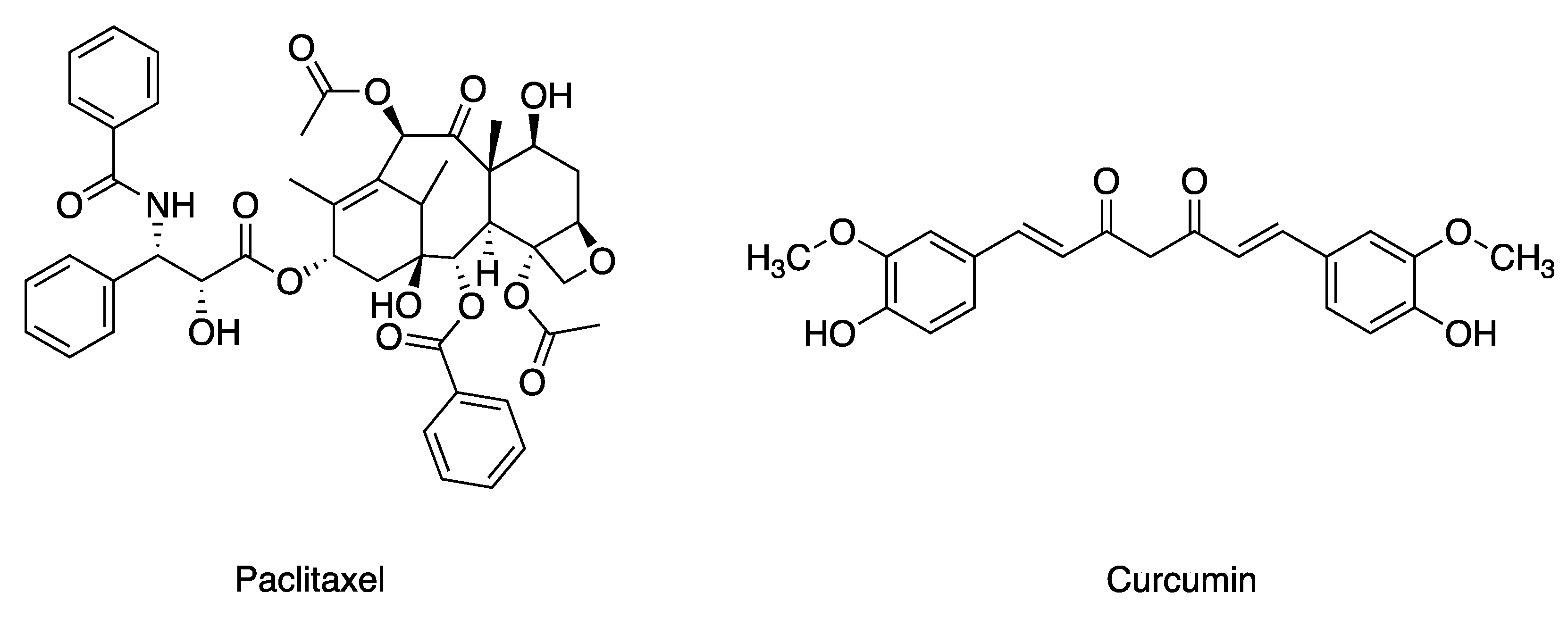
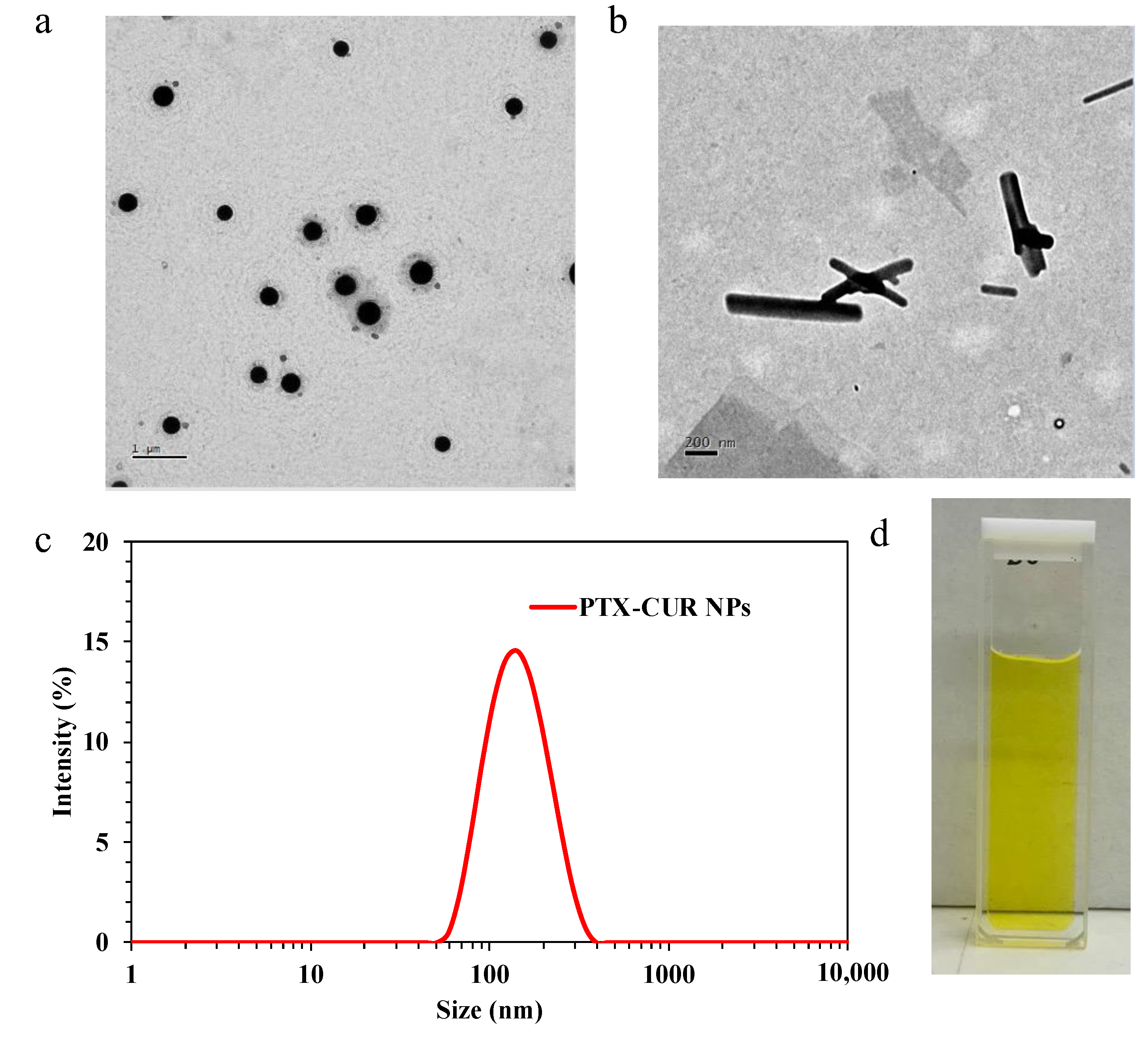

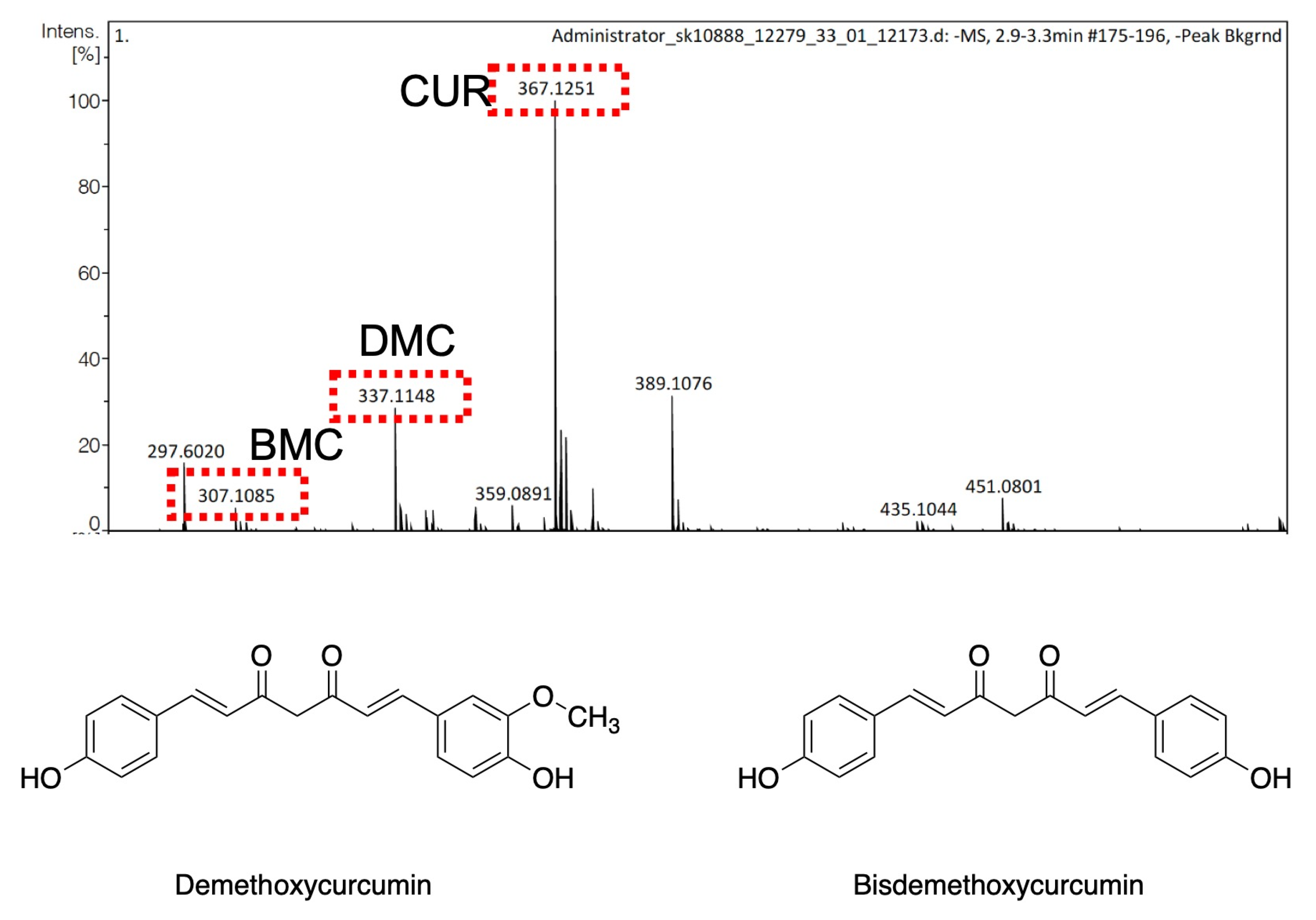
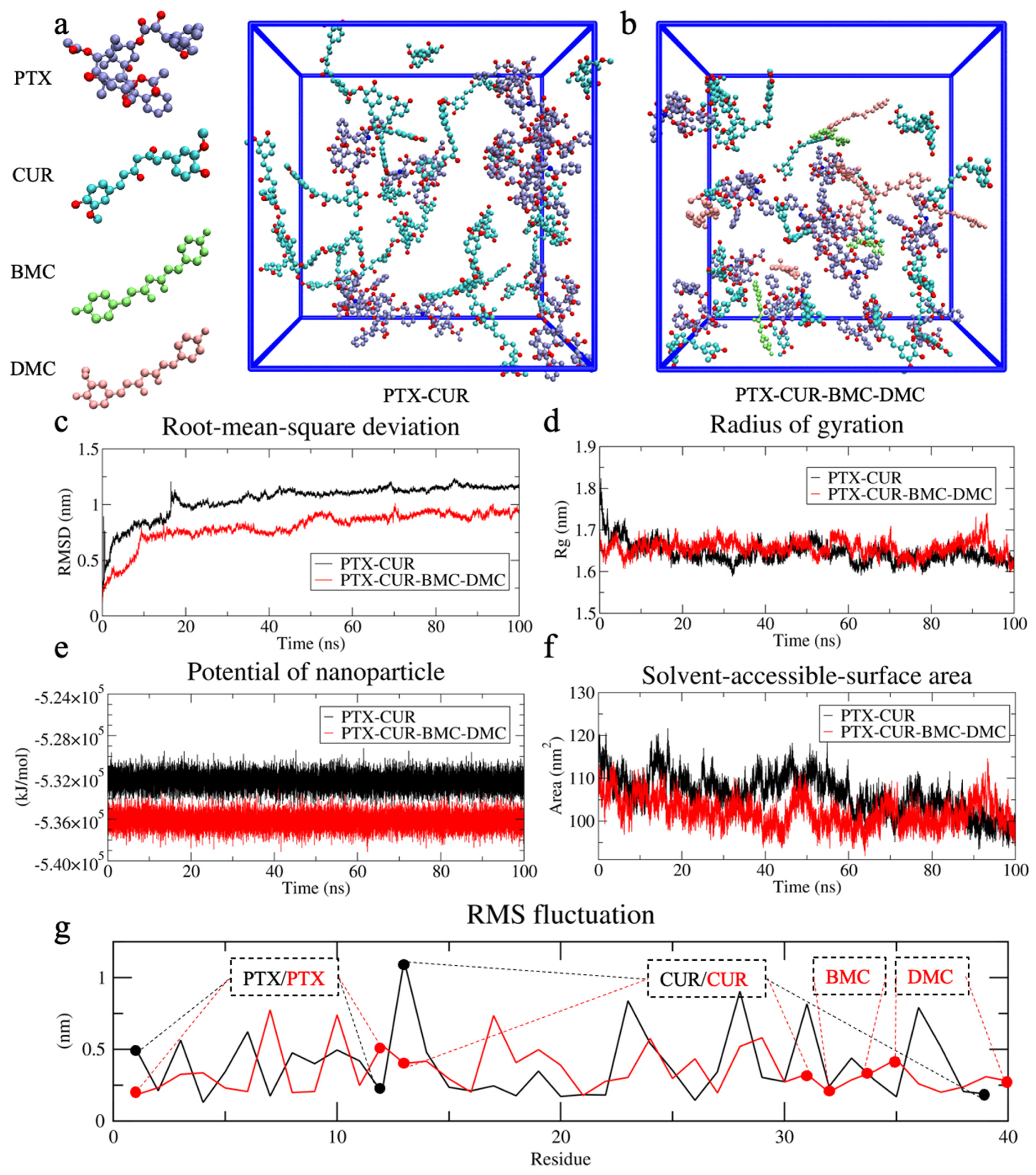
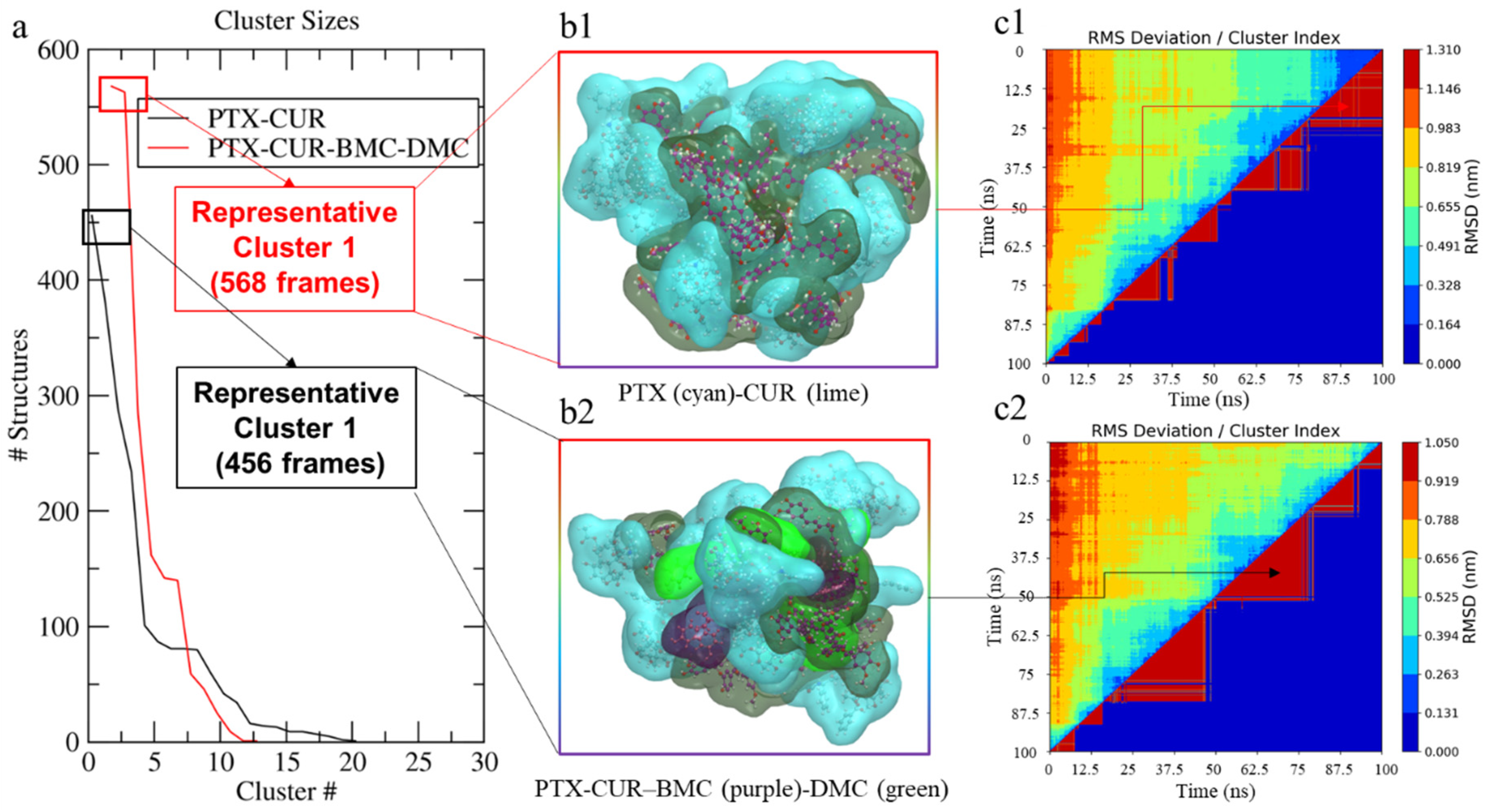

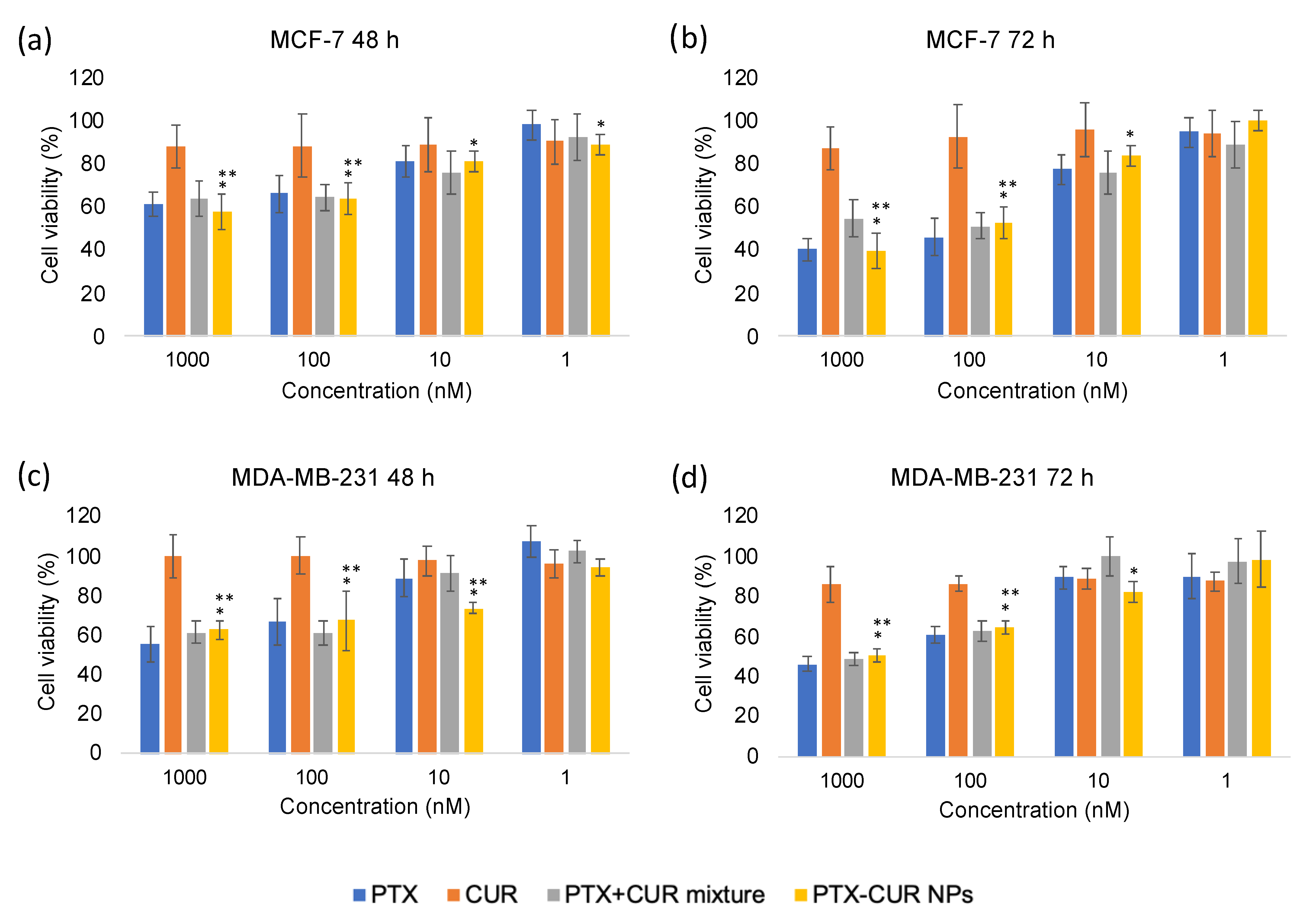
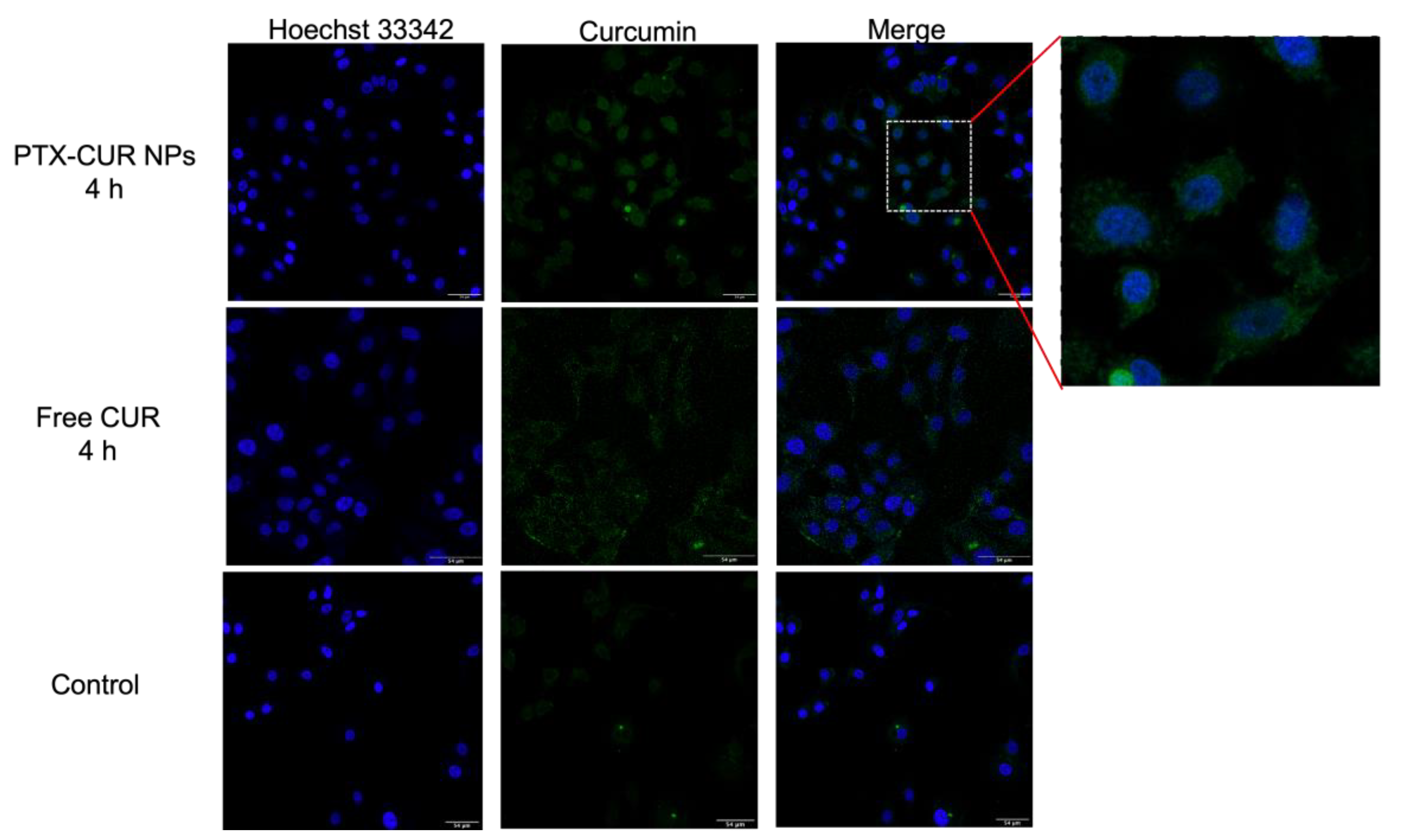
| Weight Ratio | Average Size (nm) | PDI | Appearance at Day 2 | |
|---|---|---|---|---|
| CUR | PTX | |||
| 1 | 0 | 189 ± 2.56 | 0.13 ± 0.003 | Clear |
| 0 | 1 | 679 ± 87 | 0.52 ± 0.18 | Large aggregation |
| 1 | 1 | 162 ± 11.2 | 0.18 ± 0.002 | Clear |
| 1 | 2 | 119 ± 18 | 0.21 ± 0.003 | Clear |
| 1 | 3 | 300 ± 34.7 | 0.45 ± 0.04 | Large aggregation |
| 2 | 1 | 124 ± 28.2 | 0.15 ± 0.1 | Clear |
| 3 | 1 | 222 ± 48 | 0.30 ± 0.14 | Some aggregation |
| CUR Purity | WPTX/WPEG | Average Size (nm) | PDI |
|---|---|---|---|
| >98% | 1:0.1 | 1520 ± 264 | 1.00 |
| 1:0.5 | 2160 ± 396 | 1.00 | |
| 1:1 | 6150 ± 323 | 0.70 ± 0.15 | |
| 1:2 | 2490 ± 100 | 0.65 ± 0.06 | |
| 1:5 | 2900 ± 283 | 1.00 |
| Sample | NP Composition (Weight Ratios) | Average Size/nm | PDI |
|---|---|---|---|
| 1 | PTX and 65% pure CUR (1:1) | 126 ± 4.25 | 0.19 ± 0.002 |
| 2 | PTX and 98% pure CUR (1:1) | 4020 ± 84 | 1.00 |
| 3 | PTX and BMC (1:1) | 3870 ± 67 | 1.00 |
| 4 | PTX and DMC (1:1) | 5920 ± 195 | 1.00 |
| 5 | PTX, BMC, and DMC (1:0.5:0.5) | 208 ± 22.6 | 0.52 ± 0.1 |
| 6 | PTX, 98% CUR, and BMC (1:0.5:0.5) | 290 ± 36.84 | 0.48 ± 0.03 |
| 7 | PTX, 98% CUR, and DMC (1:0.5:0.5) | 207 ± 27.02 | 0.40 ± 0.02 |
| 8 | PTX, 98% CUR, BMC, and DMC (1:0.33:0.33:0.33) | 223 ± 33.20 | 0.42 ± 0.1 |
| 9 | PTX, 98% CUR, BMC, and DMC(1:0.7:0.1:0.2) | 160 ± 3.06 | 0.20 ± 0.007 |
Publisher’s Note: MDPI stays neutral with regard to jurisdictional claims in published maps and institutional affiliations. |
© 2022 by the authors. Licensee MDPI, Basel, Switzerland. This article is an open access article distributed under the terms and conditions of the Creative Commons Attribution (CC BY) license (https://creativecommons.org/licenses/by/4.0/).
Share and Cite
Karaosmanoglu, S.; Zhang, Y.; Zhou, W.; Ouyang, D.; Chen, X. Synthesis of Carrier-Free Paclitaxel–Curcumin Nanoparticles: The Role of Curcuminoids. Bioengineering 2022, 9, 815. https://doi.org/10.3390/bioengineering9120815
Karaosmanoglu S, Zhang Y, Zhou W, Ouyang D, Chen X. Synthesis of Carrier-Free Paclitaxel–Curcumin Nanoparticles: The Role of Curcuminoids. Bioengineering. 2022; 9(12):815. https://doi.org/10.3390/bioengineering9120815
Chicago/Turabian StyleKaraosmanoglu, Sena, Yunsen Zhang, Wenli Zhou, Defang Ouyang, and Xianfeng Chen. 2022. "Synthesis of Carrier-Free Paclitaxel–Curcumin Nanoparticles: The Role of Curcuminoids" Bioengineering 9, no. 12: 815. https://doi.org/10.3390/bioengineering9120815
APA StyleKaraosmanoglu, S., Zhang, Y., Zhou, W., Ouyang, D., & Chen, X. (2022). Synthesis of Carrier-Free Paclitaxel–Curcumin Nanoparticles: The Role of Curcuminoids. Bioengineering, 9(12), 815. https://doi.org/10.3390/bioengineering9120815







